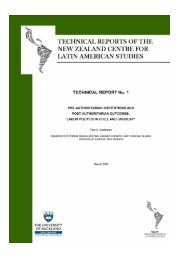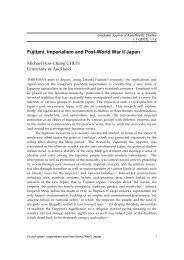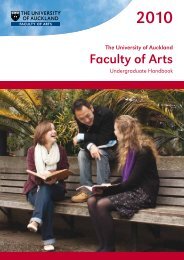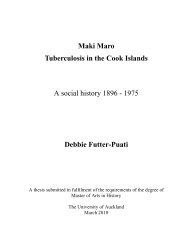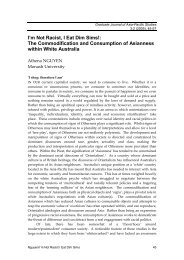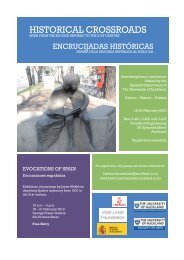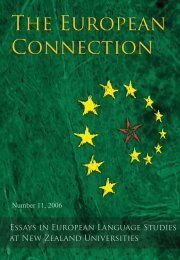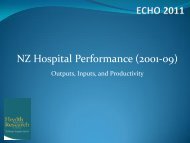Cotterell powerpoint presentation - The University of Auckland
Cotterell powerpoint presentation - The University of Auckland
Cotterell powerpoint presentation - The University of Auckland
You also want an ePaper? Increase the reach of your titles
YUMPU automatically turns print PDFs into web optimized ePapers that Google loves.
<strong>The</strong> <strong>University</strong> <strong>of</strong> <strong>Auckland</strong> New ZealandMonitoring Social Change withExisting Data: <strong>The</strong> Family andWhanau Wellbeing ProjectMark Wheldon and Gerry <strong>Cotterell</strong>Department <strong>of</strong> Sociology, Social Statistics Research Group<strong>The</strong> <strong>University</strong> <strong>of</strong> <strong>Auckland</strong><strong>The</strong> Social Policy, Research and Evaluation Conference3- 5 April 2007, Wellington
Outline<strong>The</strong> <strong>University</strong> <strong>of</strong> <strong>Auckland</strong> New Zealand 23 November 2006<strong>The</strong> Family and Whanau Wellbeing ProjectIntroductionData access and preparationDefinitions <strong>of</strong> families and households in the censusBuilding family-level indicatorsPreliminary indicator results
<strong>The</strong> Family and WhanauWellbeing Project (FWWP)<strong>The</strong> <strong>University</strong> <strong>of</strong> <strong>Auckland</strong> New Zealand 23 November 2006MultidisciplinarySociologyStatisticsFunded by FRST for five yearsCreating a social monitorFocus on households and familiesConstructing social indicators <strong>of</strong> wellbeingUsing existing time-series data (mainly Census)Adding analytical value to <strong>of</strong>ficial data sourcesCan they form the basis for a data platform?
What we want to do in the project<strong>The</strong> <strong>University</strong> <strong>of</strong> <strong>Auckland</strong> New Zealand 23 November 2006Objectives1. Develop standard measures– Household/family composition– Socio-economic status– Family wellbeing2. Analyse family wellbeing in context– Wellbeing by family type and social location3. Set time-series analysis <strong>of</strong> social indicators– Interrelationships over time4. Explore feasibility <strong>of</strong> routine monitoring– Data platform, data linkage and “fusion”, pseudo cohort
Time Series<strong>The</strong> <strong>University</strong> <strong>of</strong> <strong>Auckland</strong> New Zealand 23 November 2006Householdsor FamilyTypeType AType BType CType DType E1981 1986 1991 1996 2001A 1A 2 A 3 A 4 A 5B 1 B 2 B 3 B 4 B 5C 1C 2C 3 C 4C 5D 1D 2D 3D 4D 5E 1E 2E 3E 4E 5Changing distributions <strong>of</strong> outcomes for household or family type
Data Preparation<strong>The</strong> <strong>University</strong> <strong>of</strong> <strong>Auckland</strong> New Zealand 23 November 2006Data obtained through Statistics NZ Data LaboratoryAccess to the data used in this study was provided by Statistics New Zealand in asecure environment designed to give effect to the confidentiality provisions <strong>of</strong> theStatistics Act 1975.Indicator validity is partly dependent on the quality <strong>of</strong> source dataTime-series analysis <strong>of</strong> 20 years <strong>of</strong> data from 5 censuses an ambitious task,tried here for the first timeRequired data dictionaries and detailed variable assessmentsSources already availableExisting resources enhanced, new ones created.Project team was advised by Statistics NZ in this processOutlined in Family Wellbeing Indicators from the 1981–2001 Censuses(Milligan et al., 2006)
Variable Comparability<strong>The</strong> <strong>University</strong> <strong>of</strong> <strong>Auckland</strong> New Zealand 23 November 2006Major component <strong>of</strong> data assessment processSignificant for time-series validity <strong>of</strong> indicatorsEighteen different factors affecting variable comparabilitywere identifiedEach variable used in the indicators was assessed usinga comparability scaleComparability: Total -> High -> Broad -> Limited(Milligan et al., 2006, pp.46–50)
Census Families<strong>The</strong> <strong>University</strong> <strong>of</strong> <strong>Auckland</strong> New Zealand 23 November 2006Wellbeing indicators at the level <strong>of</strong> the family<strong>The</strong> census definition <strong>of</strong> family is limited to nuclearfamilies consisting <strong>of</strong> ‘parents’ and ‘children’:‘Parent’ ≡ ‘Guardian’, a person in a parenting roleparents need not be married nor in an <strong>of</strong>ficial union, norbiological parents <strong>of</strong> their ‘children’Parents and children must live in the same dwellingCertain types <strong>of</strong> ‘family’ cannot be identified in censusrecords
Families not identifiable<strong>The</strong> <strong>University</strong> <strong>of</strong> <strong>Auckland</strong> New Zealand 23 November 2006Multi-dwelling families, e.g.,separated parents have dual custodyExtended familiescharacteristic <strong>of</strong> families in some cultures,e.g., Māori and Pacific PeoplesFamilies with children living away fromhome, e.g,tertiary students living in halls <strong>of</strong> residenceor flats
Family Types<strong>The</strong> <strong>University</strong> <strong>of</strong> <strong>Auckland</strong> New Zealand 23 November 2006Family structures can be classified for comparativeanalysisSNZ family type classification modified and extendedAdded some ‘household’ groups for informativecomparisons e.g.,One-person households excluded from definition <strong>of</strong> ‘family’Couples without children and one-person householdswere further classified as ‘retired’ or ‘non-retired’Retired: Both partners either over 65 yrs or in receipt <strong>of</strong> NZ SuperNon-retired: Neither or only one partner over 65 yrs or in receipt <strong>of</strong>NZ SuperClassification is operational rather than definitive
Selected Family Types<strong>The</strong> <strong>University</strong> <strong>of</strong> <strong>Auckland</strong> New Zealand 23 November 2006Couples with children1. Couple with dependent children2. Couple with only independent childrenOne parent families3. One parent family with dependent children4. One parent family with only independent childrenFamilies/households without children5. Couple without children (non-retired)6. One-person household (non-retired)7. Retired family/household8. Non-family household
Using Census Data to ConstructWellbeing Indicators<strong>The</strong> <strong>University</strong> <strong>of</strong> <strong>Auckland</strong> New Zealand 23 November 2006<strong>The</strong> advantages <strong>of</strong> using Census dataIdentification <strong>of</strong> core positive outcomes with objective livingconditionsAbility to assess change over timePopulation coverage rather than sample<strong>The</strong> limitations <strong>of</strong> using Census dataLimited range <strong>of</strong> information coverage by CensusLack <strong>of</strong> data for some indicatorsLack <strong>of</strong> in-depth information for some indicators
Wellbeing Indicators<strong>The</strong> <strong>University</strong> <strong>of</strong> <strong>Auckland</strong> New Zealand 23 November 2006WellbeingComponentIncomeEducationIndicatorselectedEquivalised familyincomeIncome sourceProportion <strong>of</strong>families with lowincomesIncome inequalitySecondaryeducationalattainmentPost-secondaryeducationalattainmentDefinition<strong>The</strong> median value <strong>of</strong> all equivalised family income<strong>The</strong> proportion <strong>of</strong> all families with one or more familymember receiving any type <strong>of</strong> government transfer,except family benefit or New Zealand Superannuation<strong>The</strong> proportion <strong>of</strong> all families whose equivalised grossfamily income is less than 60 percent <strong>of</strong> the medianequivalised gross family income<strong>The</strong> X proportion <strong>of</strong> all families who earn Y percentage<strong>of</strong> the total income <strong>of</strong> all families (Gini index, Lorenzcurve)<strong>The</strong> proportion <strong>of</strong> all families who have one or morefamily member(s) aged 15 or over with any secondaryqualifications<strong>The</strong> proportion <strong>of</strong> all families who have one or morefamily member(s) aged 15 or over with any postsecondaryqualifications
Wellbeing Indicators cont.<strong>The</strong> <strong>University</strong> <strong>of</strong> <strong>Auckland</strong> New Zealand 23 November 2006WellbeingComponentIndicatorselectedDefinitionWork Unemployment <strong>The</strong> proportion <strong>of</strong> all families containing at least onefamily member aged 15 or over who is unemployedHours worked<strong>The</strong> proportion <strong>of</strong> all families containing at least onefamily member who works more than 48 hours a weekHousing Tenure <strong>The</strong> proportion <strong>of</strong> all families that do not live in owneroccupieddwellingsHealthRentalaffordabilityCrowdingHealth relatedbenefits<strong>The</strong> proportion <strong>of</strong> all families in rented dwellings whereweekly rent is greater than 25 percent <strong>of</strong> the grossequivalised household income<strong>The</strong> proportion <strong>of</strong> all families living in households thatrequire at least one additional bedroom to meet thesleeping needs <strong>of</strong> the household<strong>The</strong> proportion <strong>of</strong> all families/households with one ormore member receiving either a sickness or invalid’sbenefit
Median equivalised gross incomeby family type<strong>The</strong> <strong>University</strong> <strong>of</strong> <strong>Auckland</strong> New Zealand 23 November 20061999 DollarsMedian equivalised gross income by family type60000550005000045000400003500030000250002000015000100001981 1986 1991 1996 2001YearCouple without children Couple with dependent children Couple with only independent childrenOne parent family with dependent children One parent family with only impendent children<strong>The</strong> results presented in this study are the work <strong>of</strong> the author, not Statistics New Zealand.
Low income families<strong>The</strong> <strong>University</strong> <strong>of</strong> <strong>Auckland</strong> New Zealand 23 November 2006PercentageProportions <strong>of</strong> family types below 60 percent <strong>of</strong> median equivalised gross family income80.070.060.050.040.030.020.010.00.01981 1986 1991 1996 2001YearCouple without children Couple with dependent children Couple with only independent childrenOne parent family with dependent childrenOne parent family with only independent children<strong>The</strong> results presented in this study are the work <strong>of</strong> the author, not Statistics New Zealand.
Household crowding<strong>The</strong> <strong>University</strong> <strong>of</strong> <strong>Auckland</strong> New Zealand 23 November 2006Percentage100.090.080.070.060.050.040.030.020.010.00.0Proportions <strong>of</strong> families in rented dwellings whose weekly rent is greater than 25 percent <strong>of</strong> theirgross equivalised weekly household income1981 1986 1991 1996 2001Couple without children Couple with dependent children Couple with only independent childrenOne parent family with dependent childrenYearOne parent family with only independent children<strong>The</strong> results presented in this study are the work <strong>of</strong> the author, not Statistics New Zealand.
Home ownership<strong>The</strong> <strong>University</strong> <strong>of</strong> <strong>Auckland</strong> New Zealand 23 November 2006PercentageProportion <strong>of</strong> families that do not live in owner-occupied dwellings70.060.050.040.030.020.010.00.01981 1986 1991 1996 2001YearCouple without children Couple with dependent children Couple with only independent childrenOne parent family with dependent childrenOne parent family with only independent children<strong>The</strong> results presented in this study are the work <strong>of</strong> the author, not Statistics New Zealand.
Rental affordability<strong>The</strong> <strong>University</strong> <strong>of</strong> <strong>Auckland</strong> New Zealand 23 November 2006Percentage100.090.080.070.060.050.040.030.020.010.00.0Proportions <strong>of</strong> families in rented dwellings whose weekly rent is greater than 25 percent <strong>of</strong> theirgross equivalised weekly household income1981 1986 1991 1996 2001Couple without children Couple with dependent children Couple with only independent childrenOne parent family with dependent childrenYearOne parent family with only independent children<strong>The</strong> results presented in this study are the work <strong>of</strong> the author, not Statistics New Zealand.
Secondary school qualifications<strong>The</strong> <strong>University</strong> <strong>of</strong> <strong>Auckland</strong> New Zealand 23 November 2006PercentageProportion <strong>of</strong> families where no family members have any post-secondary school qualifications90.080.070.060.050.040.030.020.010.01981 1986 1991 1996 2001YearCouple without children Couple with dependent children Couple with only independent childrenOne parent family with dependent childrenOne parent family with only independent children<strong>The</strong> results presented in this study are the work <strong>of</strong> the author, not Statistics New Zealand.
Post secondary schoolqualifications<strong>The</strong> <strong>University</strong> <strong>of</strong> <strong>Auckland</strong> New Zealand 23 November 2006PercentageProportion <strong>of</strong> families where no family members have any secondary school qualifications70.060.050.040.030.020.010.00.01981 1986 1991 1996 2001YearCouple without children Couple with dependent children Couple with only independent childrenOne parent family with dependent childrenOne parent family with only independent children<strong>The</strong> results presented in this study are the work <strong>of</strong> the author, not Statistics New Zealand.
Concluding comments<strong>The</strong> <strong>University</strong> <strong>of</strong> <strong>Auckland</strong> New Zealand 23 November 2006Time-series can be constructed from historical censusdata, subject to some limitations, e.g.:Comparability imposes certain restrictionsFamilies restricted to the same householdCensus as a data source has its own strengthsUnparalleled breadth <strong>of</strong> contextual information availableLong runningMandatory for all New ZealandersOn-going/future researchWellbeing for different ethnic groups and family typesFeasibility <strong>of</strong> family-level cohort studies from census dataPotential for further fine-grained analysis at family level
FWWP-related Publications<strong>The</strong> <strong>University</strong> <strong>of</strong> <strong>Auckland</strong> New Zealand 23 November 2006http://www.spear.govt.nz/publications/http://www.stats.govt.nz/analytical-reports/default.htm




